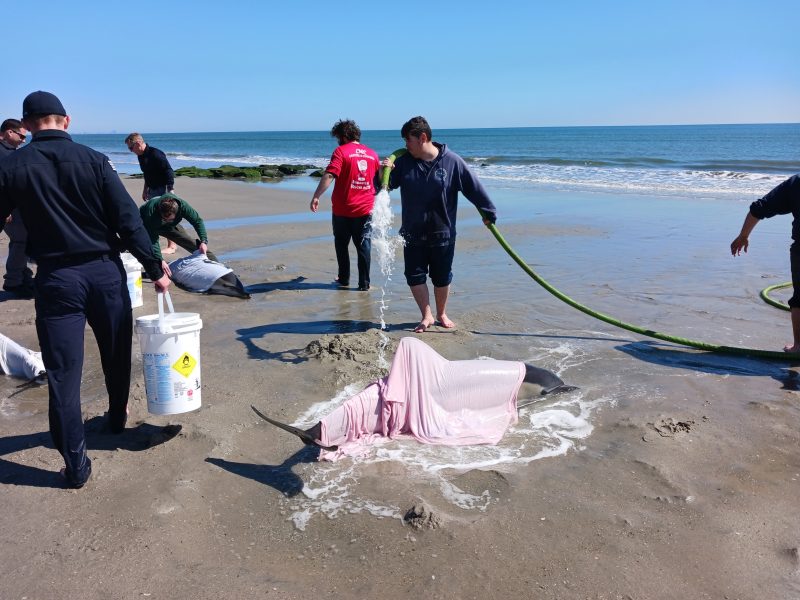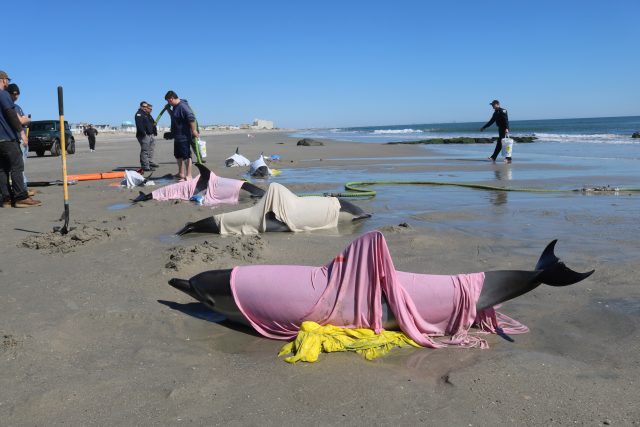By DONALD WITTKOWSKI and MADDY VITALE
Police officers and other first responders used buckets and fire hoses to pour seawater on a group of dolphins in a frantic effort to save the creatures after they became stranded on the beach Tuesday morning in Sea Isle City.
Ultimately, the rescue attempt proved futile. The heartbreaking scene took a tragic turn when a veterinarian from the Marine Mammal Stranding Center decided to euthanize the dolphins after their condition deteriorated.
“The decision was made to humanely euthanize the dolphins to prevent further suffering, as returning them to the ocean would have only prolonged their inevitable death,” the center said in a statement.
The mass stranding included eight common dolphins. Their remains were transported to a New Jersey laboratory to determine the cause of death.
“We share in the public’s sorrow for these beautiful animals, and hope that the necropsies will help us understand the reason for their stranding,” the Marine Mammal Stranding Center said.
Two of the dolphins became stranded on the 51st Street beach and died almost immediately. Six other dolphins were beached on 52nd Street, but were kept alive for nearly three hours by police officers, firefighters and employees from the Sea Isle Public Works Department by pouring water over their bodies.
“I’m trying my best,” Public Works employee Charles Poole said as he used a fire hose to spray seawater on the dolphins.
Sea Isle Police Chief Anthony Garreffi said first responders were advised by the Marine Mammal Stranding Center in Brigantine to cover the dolphins with wet wraps to keep their skin moist.
Some of the police officers and other first responders who were part of the rescue effort were in bare feet as they carried plastic buckets into the ocean to fill them with chilly water.
“We had police officers running buckets of water back and forth,” Garreffi said.

The dolphins were stuck in the beach sand, virtually motionless except to lift their heads and tails. Onlookers who gathered on the beach were saddened to see the helpless creatures.
“Is there anything I can do to help?” Bob Gillman called out to the first responders.
Gillman and his co-workers from a heating and air-conditioning company had been working on a house nearby when they found out about the dolphins and rushed down to the beach to help save them.
“This is absolutely sad,” Gillman said. “I wish there was something we could do to keep them alive.”
After a veterinarian and staff members from the Marine Mammal Stranding Center arrived at the scene, the six live dolphins were placed in the back of pickup trucks and driven away. Later, the center announced on its Facebook page that the dolphins were euthanized.
The bodies of the two dolphins that died on the beach were removed by Sea Isle workers in a pickup truck.
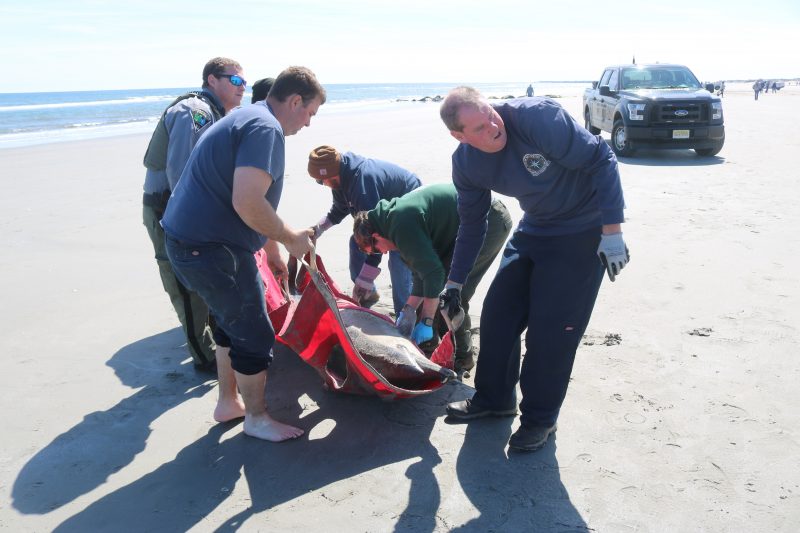
Garreffi, who has been a member of the Sea Isle Police Department for more than 20 years, said this was the first time he had ever seen a mass stranding of dolphins.
In an interview, Garreffi said police were told by the Marine Mammal Stranding Center that common dolphins, like the ones that became stranded, normally stay in deeper waters. It is unusual for them to be so close to the beach, he said.
Tim Ramsey, a Sea Isle resident who has an oceanfront home at 52nd Street, said he spotted a large group of dolphins racing back and forth when some of them suddenly veered toward the beach.
“They just swam straight in. It was weird,” he said.
Ramsey said he first thought the dolphins were either playing in the surf or were chasing fish for food.
“It was probably the most dolphins I’ve ever seen. They were all just playing follow the leader,” he said, while estimating that the entire group included about 50 dolphins.
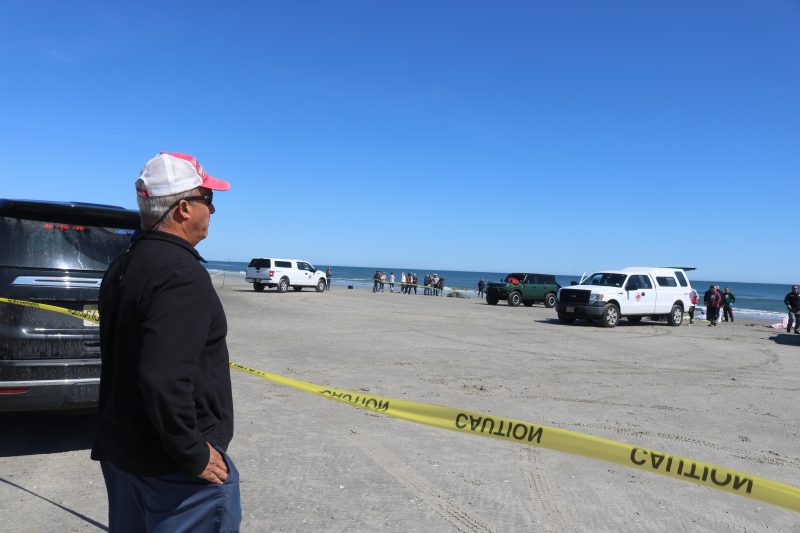
Ramsey called police at about 11 a.m. after the dolphins became stranded. He grabbed a pair of boots and had considered trying to carry the dolphins back into the water, but was told by police to leave them on the beach, he said.
Other dolphins have washed up along the Jersey Shore this year, but this was the largest group to become stranded so far. In addition, 29 dead whales – nine in New Jersey – have washed up on the East Coast since December.
There are suspicions that sonar mapping of the seabed for a series of proposed offshore wind energy farms along the East Coast may be contributing to the mammals’ deaths. One of the wind farms is proposed off the New Jersey coast from Atlantic City to Stone Harbor.
However, the National Oceanic and Atmospheric Administration, the New Jersey Department of Environmental Protection and the Marine Mammal Stranding Center are among the government agencies or organizations that dispute any connection between the wind farms and the dead whales.
“As of March 2023, no offshore wind-related construction activities have taken place in waters off the New Jersey coast, and DEP is aware of no credible evidence that offshore wind-related survey activities could cause whale mortality,” the DEP said in a statement last week.
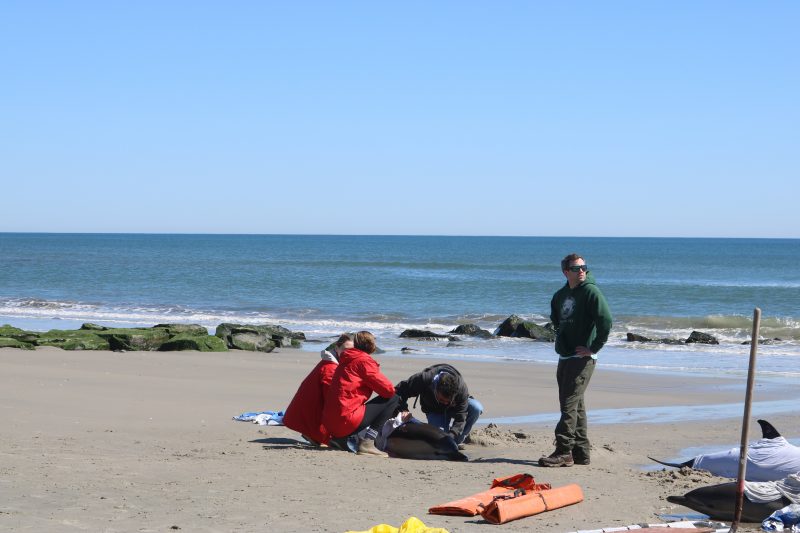
NOAA and the Marine Mammal Stranding Center have concluded that most of the whale deaths were caused by vessel strikes after examining the carcasses and finding the types of injuries consistent with collisions with ships.
Hundreds of people attended a community meeting in Ocean City and a congressional hearing in Wildwood last week to discuss the whale deaths and point fingers at the wind farms.
U.S. Rep. Jeff Van Drew, whose congressional district includes the shore towns in Atlantic and Cape May counties, said he believes the wind farms are responsible for the whale deaths.
In even stronger comments, Van Drew accused the Danish energy company Orsted, which plans to build a wind farm 15 miles offshore from Atlantic City to Stone Harbor, of misleading the public about the environmental impacts of the project.
“They lied,” Van Drew bluntly said during the congressional hearing he conducted in Wildwood.
As part of their congressional inquiry of wind farm technology, Van Drew and other Republicans are calling for a moratorium on all of the offshore projects until an investigation is done to establish whether there are any links to the whale deaths.

On Tuesday, someone used seashells to inscribe the words “No Windmills” on the beach close to where the eight dolphins were stranded.
Eileen Cameron, a Sea Isle resident who watched while rescuers tried saving the dolphins, said she believes sonar mapping of the seabed for the wind farms is disturbing the internal navigation systems of the whales and possibly dolphins.
“I swear it’s the sonar. It’s definitely throwing them off,” Cameron said in an interview.
Cameron also disputed reports that most of the whale deaths have been caused by vessel strikes.
“They keep saying it’s vessel strikes. But these are no boating accidents,” she said.
